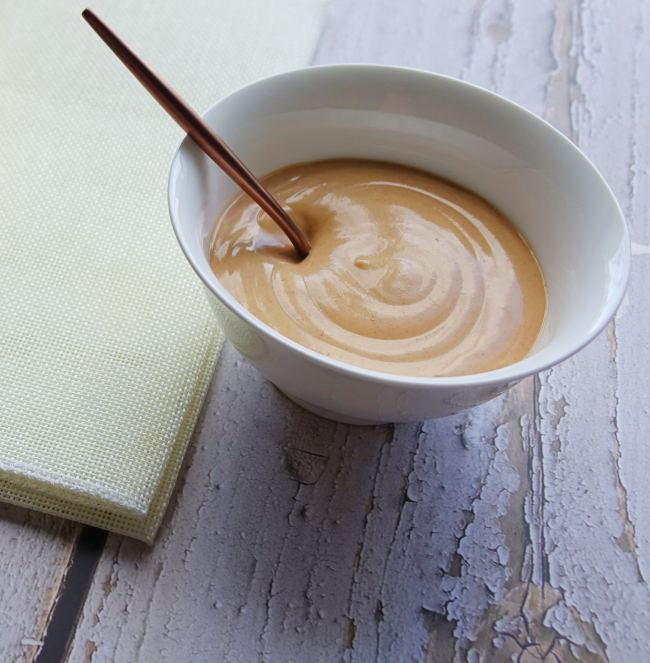
Whip up this incredibly easy Peanut Sauce Recipe in minutes! This simple, 3 ingredient peanut sauce, featuring peanut butter, apple juice, and honey, creates a versatile homemade peanut sauce perfect as a peanut dipping sauce for spring rolls or veggies, a flavorful peanut salad dressing, or a delicious addition to stir-fries.
- Servings 11
- Prep time 10 min
- Cooking 7 min
- Calories: 87 kcal
- Protein: 2.8 g
- Fat: 6.1 gm
- Saturated Fat: 1.1 g
- Carbohydrates: 7.1 g
- Dietary Fiber: 0.8 g
- Sugars: 5.0 g
- Sodium: 1.8 mg
- Half a cup of smooth peanut butter (natural, without added sugars or oils is preferable)
- Half a cup of apple juice or apple cider (choose unsweetened for a healthier option)
- Two tablespoons of honey (adjust to taste)
- Measuring Spoons
- Blender or Food Processor
- Saucepan
- Whisk
- Spatula
- In a medium bowl, combine the peanut butter and honey.
- Gradually pour the apple juice or cider while whisking or stirring with a fork, Incorporate it slowly to ensure it mixes well with the peanut butter and honey.
- Continue to mix until well blended. If the sauce is too thick, add more apple juice or cider, a little at a time, until you reach your preferred consistency. If it’s too thin, add more peanut butter. Taste the sauce and add more honey if you like it sweeter.
- Serve or Store: this peanut sauce can be served immediately or stored in an airtight container in the refrigerator for up to a week. Before using it from the fridge, stir it again to refresh the consistency.
- Heating (Optional): If you prefer warm peanut sauce, gently heat it on the stove over low heat, stirring constantly to prevent sticking. Do not boil the sauce, as high heat can cause the sauce to seize or separate.
- This sauce pairs wonderfully with dishes like chicken satay salad dressings or drizzled over a stir-fry for a quick flavor boost. The natural sweetness and tanginess from the apple create a perfect balance with the rich, nutty flavor of the peanut butter, and the honey ties everything together with a touch of sweetness. Enjoy your homemade 3-Ingredient Peanut Sauce!
Peanut butter, a beloved staple in many households, and it’s also a versatile ingredient in sweet and savory dishes. However, with the ever-growing variety of peanut butter options on the market, it’s essential to understand the different types of peanut butter and determine your healthiest choice.
- Creamy Peanut Butter: This classic peanut butter is smooth and creamy in texture. It’s made by grinding roasted peanuts until they form a smooth, spreadable consistency. Creamy peanut butter is a good choice for sandwiches, baking, or as a dip for fruits and vegetables.
- Chunky Peanut Butter: As the name suggests, chunky peanut butter contains small pieces of roasted peanuts, providing a delightful crunch. It’s a favorite among those who enjoy a bit of texture in their peanut butter.
- Natural Peanut Butter: It is made with just two ingredients: peanuts and a pinch of salt. Unlike other varieties, it doesn’t contain added sugars, oils, or preservatives. The oil separation in natural peanut butter is a sign of its purity, and you can simply stir it back in before use.
- Organic Peanut Butter: Organic peanut butter is made from peanuts grown without synthetic pesticides or fertilizers. It’s often available in creamy and chunky varieties and is a good choice for those seeking a more environmentally conscious option.
- Low-Sodium Peanut Butter: If you’re watching your sodium intake, low-sodium peanut butter is available, typically containing less salt than regular peanut butter.
- Low-Sugar Peanut Butter: If you’re concerned about added sugars, choose peanut butter with no added sugar or sweeteners. Some commercial peanut butter contains added sugar, which can contribute to excess calorie
- Homemade Peanut Butter: The healthiest peanut butter might be the one you make yourself. Homemade peanut butter allows you to control the ingredients, ensuring that you use high-quality peanuts and can avoid additives altogether.
Conclusion. The healthiest peanut butter for you depends on your dietary goals and preferences. Whether you choose natural, organic, low-sugar, or low-sodium peanut butter, you must read labels carefully to make an informed choice. Ultimately, peanut butter can be a valuable source of protein, healthy fats, and essential nutrients. Also, it should be consumed in moderation as part of a balanced diet.
